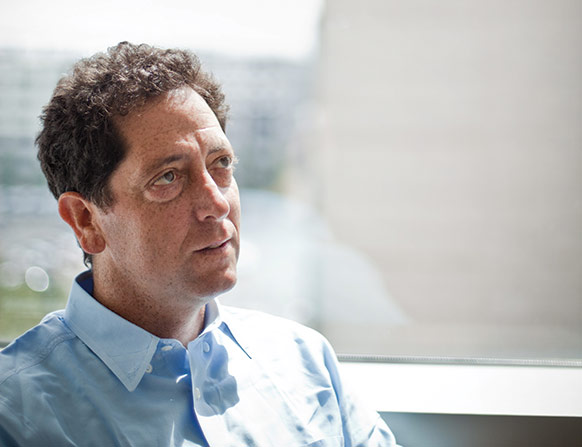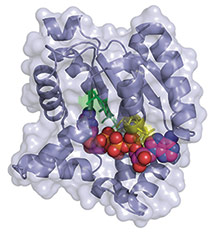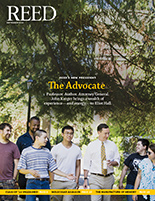
IRIS login | Reed College home Volume 91, No. 3: September 2012
The Molecular Assassin

Photo by Ariel Zambelich
Chemist Kevan Shokat ’86 defied convention and opened a new front in the war on cancer.
By William Abernathy ’88

Cellular workhorse.
Much of the day-to-day scutwork of a cell—eating, flexing, taking out the garbage, talking to the neighbors, and so on—is governed by special enzymes called kinases. Kinases transfer energy by moving phosphate radicals from molecule to molecule and from kinase to kinase throughout the cell. Break a single link in one of these long, delicate chains and the cell stops dead in its tracks.
The cancer was spreading.
It began years ago, when a single kidney cell reproduced improperly. A tiny section of DNA was copied wrong. Cellular fail-safes failed. The immune system didn’t recognize the cell as a threat and, unchecked, it began reproducing. Dividing and pressing on, its daughter cells advanced and reproduced with the brainless, remorseless urgency of the bucket-wielding mops in Fantasia. The patient tried one treatment after another, without success; the cancer cells continued their relentless reproduction, threatening to destroy organs, crowd out healthy tissues, and leech away vital resources until the patient died.
Owing to medical confidentiality laws, we can’t say who the patient is, or where he or she lives. We can say, though, that the patient's cancer cells are in retreat, for now, thanks to an experimental drug devised by Kevan Shokat ’86.
“That’s what I’m hooked on now,” he says of the drug trials. “Seeing [our] drug and seeing every patient on the trial, what cancer they had, how long they had other therapies.” Patients who had been on two-month trial after two-month trial with other ineffectual drugs, then changed to his new compound. “Then they’re on [our] drug for 15 months! You know it’s doing something. It’s so exciting!”
A pioneer in the new intellectual discipline of chemical biology, Kevan uses sophisticated techniques (many of which he invented) to unlock the secrets of kinases, complex molecules that help cells live, work, and—crucially—die. Armed with this knowledge, he is producing new medicines that attack cancer and other diseases by disrupting the chemical machinery of deviant or invading cells, while leaving healthy cells unharmed—molecular arrows, if you will, in a war long dominated by carpet bombing.
![]()
On a gray San Francisco day, Kevan sits in his corner office above UC San Francisco’s gleaming new Mission Bay biosciences campus. Chair of UCSF’s department of cellular and molecular pharmacology and tenured at UC Berkeley, Shokat is a Howard Hughes investigator, endowed by the late billionaire’s fortune to advance biomedical science. He runs a lab of 16 graduate students and postdoctoral researchers who dash about with focused intensity, some working behind computers, others fiddling with chemical-laden beakers behind fume hoods, as chemists have always done.
He shows off the open corridors leading to adjacent laboratories with pride that his team is able to wander freely from lab to lab. As a Hughes investigator, his intellectual property belongs to the university, and there’s no obligation or incentive to keep secrets. “That’s a very big line for me,” he says, “We want the students and everybody to be able to talk anytime, anywhere.”
In his field, Kevan is a rock star: a member of the National Academy of Sciences and the American Academy of Arts and Sciences, Eli Lilly Award winner, Sloane Fellow, and Searle Scholar. He’s come a long way from Albany, California, a quiet, orderly suburb just north of Berkeley, where he grew up working in his parents’ print shop, running presses, printers, folders, and binders in high school and on semester breaks from Reed, which he could never have attended without financial aid.
His work ethic showed up early at Reed. “Evan Rose ’86 or Deborah Kamali ’85 would come around to the library about midnight, one a.m., to try to get me out.” (He and Deborah are now married; their son, Kasra Shokat ’14, is a junior at Reed.)
“A lot of people at Reed learned early on,” he remembers, “that you’ve got to focus on the important things, and not try to do everything. I ended up trying to do it all.”
Kevan did not come to Reed expecting to be a scientist. Though he’d taken biology and chemistry in high school, he wasn’t brimming with confidence in his first classes. “I didn’t know it very well from high school, so it was all new to me,” he recounts. “I remember all the kids from better schools. They were so far ahead. They got bored and I caught up.”
Professor Phyllis Kosen [chemistry 1981–83] really got him sold on the discipline. “She was just like a New Yorker, chain smoking, fascinated with biochemistry. She didn’t take any bullshit. She wanted top chemistry, and that just got me hooked.” Other lasting influences included his o-chem professor Nick Galakatos ’79 [chemistry 1983–84] and thesis adviser Ron McClard [chemistry 1984–].
![]()
Understanding Kevan’s work requires a step back to look at cells and how they’ve been studied. For all the attention DNA has received as the master blueprint of life, it’s not the part of the cell that keeps the lights on. The actual work of a cell—eating glucose, responding to hormonal signals, taking out waste, flexing (if it’s a muscle cell), transmitting signals (if it’s a nerve cell), reproducing, and politely killing itself when its work is done—is carried out in subtle, complex cascades of chemical causation. The guiding agents of chemical action and energy in a cell are special enzymes called kinases. Kinases transfer energy by moving phosphate radicals from molecule to molecule and from kinase to kinase throughout the cell. Breaking a single link in one of these long, delicate chains can stop a cell dead in its tracks.
When Kevan left Reed, chemically manipulating individual kinases in live cells was something that hadn’t been done. Chemists had little insight into the molecular workings of cells, and biologists were not skilled at chemical approaches to the cell. The two disciplines stood apart from each other, separated by methodology and culture.
“When Kevan started his independent career,” recalls his PhD adviser, Peter Schultz of UC Berkeley, “chemists did mimetic chemistry. They tried to make organic systems that mimicked biological systems. There were very few chemists who would actually dig into the biology itself.” But after earning his PhD in 1991, Kevan did just that, plunging headlong into cell biology with postdoctoral research in immunology at Stanford.
Breaking away from one intense discipline and picking up an apparently unrelated one was a spectacular intellectual leap. It wasn’t just difficult, though. “It [was] a huge career risk,” Schultz recalls. “When Kevan went to look for positions, people were confused as to what he was... People didn’t understand whether that person should be in the chemistry department or the biology department.”
“It was risky,” Kevan admits, “but that’s the great thing about coming from Reed. You just go after what’s exciting to you, and you don’t worry about the consequences until later.”
In the early 1990s, genetic engineering (directly manipulating DNA) was the most powerful technique in the cell biologist’s toolbox. It was at Stanford that Kevan first suggested that rather than modifying the cell’s genetic structure to manipulate kinases, one could design small molecules that would block kinase signal paths directly. “I told my adviser about it,” he recalls, “and he said, ‘That’s a stupid idea! Why would I do that? I can just knock out the gene and see what happens.’”
His adviser was advocating the conventional wisdom of the then-dominant approach, in which researchers turn off (“knock out”) a gene and hope to create a viable new mutant for study. This technique works well for studying simple, fast-breeding life forms like E.coli bacteria and yeast cells, but can become cumbersome, expensive, and maddeningly inconclusive with complex, slower-breeding organisms like mice. The “knock out" mouse may never be born, it may die too quickly to study, or its cells may simply reroute its internal chemical signals to circumvent the induced genetic defect. Even if the knock out mouse does develop as hoped, the path from a knock out mutant to a new drug is indirect: you can’t cure a patient by tampering with his or her DNA.


LATEST COMMENTS
steve-jobs-1976 I knew Steve Jobs when he was on the second floor of Quincy. (Fall...
Utnapishtim - 2 weeks ago
Prof. Mason Drukman [political science 1964–70] This is gold, pure gold. God bless, Prof. Drukman.
puredog - 1 month ago
virginia-davis-1965 Such a good friend & compatriot in the day of Satyricon...
czarchasm - 4 months ago
John Peara Baba 1990 John died of a broken heart from losing his mom and then his...
kodachrome - 7 months ago
Carol Sawyer 1962 Who wrote this obit? I'm writing something about Carol Sawyer...
MsLaurie Pepper - 8 months ago
William W. Wissman MAT 1969 ...and THREE sisters. Sabra, the oldest, Mary, the middle, and...
riclf - 10 months ago